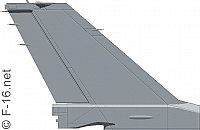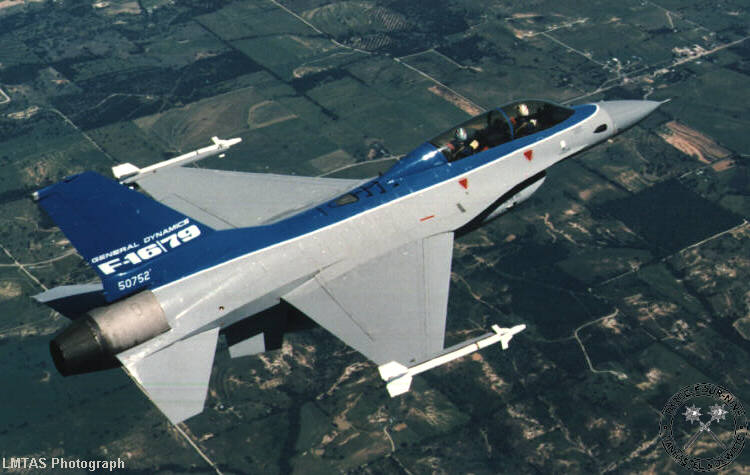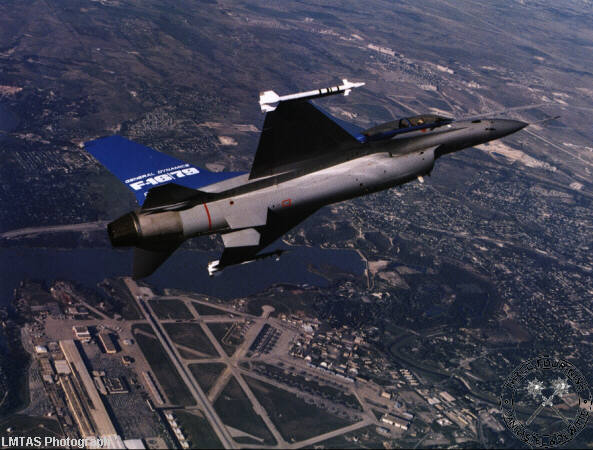 |
F-16/79FX Export Fighter |
The FX Export Fighter Program
In February of 1977, in a well-meaning but ultimately futile gesture, President Jimmy Carter announced a new arms transfer policy in an attempt to reduce arms proliferation throughout the world. Under this policy, American manufacturers could no longer sell to foreign air forces any combat aircraft that were the equal of those in the US inventory.

There were significant exceptions to this rule, e.g. the four NATO users of the F-16 and, as a special exception, the nation of Israel. Exceptions were also made for arms deliveries to Iran so that the Shah could continue to act as a bulwark against Soviet expansion in the Persian Gulf region.
At first, South Korea's request for F-16s was turned down under this new rule, but was later approved as a quid pro quo for pending US troop withdrawals from Korea. However, nations such as Jordan, Taiwan, and Venezuela were denied access to the F-16. To cater for the 'embargoed' air forces, the FX Export Fighter Program was proposed, calling for an aircraft satisfying the following criteria:
- Performance, cost & capabilities should be between those of the F-5E and F-16A
- Multirole design (but optimized for the air-to-air role) and deliberately limited strike capabilities
- Payload/range performance had to be substantially inferior to that of contemporary fighters in the US inventory
- Deployment and maintenance had to be easier.
New Engine & Structural Modifications
Because of the high financial risk involved with the FX program, only two proposals were ultimately submitted: Northrop entered the F-5G/F-20, while General Dynamics teamed with General Electric to produce a less-capable export version of the Fighting Falcon, powered by a derivative of the J79 single-shaft turbojet. This project was announced by General Dynamics in November of 1979.
Although the J79 production in the states came to an end in 1979 (13,686 engines built) and the license production in Japan ceased the following year (while production in Israel still continued for use in the Kfir), the GE engine was the obvious choice to power a low-cost, easy-to-maintain export fighter. Used to power the B-58 Hustler, the F-104 Starfighter and the F-4 Phantom, the latter two were already in widespread service with large numbers of foreign air arms.
- J79 specs
- Compressor:17 stage, 6 stages of variable stators and variable inlet vanes.
- Turbine: 3 stage
- Combustor: Cannular type, 10 burners
GE made some changes to the original design for use in the F-16/79 and designated it the J79-GE-17X. Obviously, the shape of the engine had to be altered to fit in the F-16s engine bay, furthermore a new feature was added to the engine, called Combat Plus (originally intended to boost the F-4 performance). When engaged by the pilot , Combat+ increases momentarily the fuel flow to the engine, in the mean time closing the engine nozzle slightly. This results in a net increase of the exhaust gas temperature by 100°F (56°C), producing a useful amount of extra thrust.
| F100 | J79 | J79 Combat+ | ||
|---|---|---|---|---|
| Full AB | Full AB | Full AB at sea level | Full AB at Mach 2.0/35,000ft | |
| Thrust (lbs) | 23,830 | 17,900 | 18,700 | 20,840 |
| Thrust (relative) | 100% | 75.1% | 78.5% | 87.5% |
Even with Combat Plus, performance of this new version of the J79 was significantly inferior to the F100, and Combat Plus could only be used for short periods of time when specific operating conditions were met: the engine had to be running in full AB, compressor inlet temperature should not exceed 15°F (-9°C) and certain combinations of high speed / low altitude would result in excessive internal pressure build-up (due to high airflow involved) and would place extremely high strain on the engine casing. Combat Plus was eventually fitted to Israeli Kfir C-7 aircraft, which were powered by a J79 variant.
The main drawback of the uprated J79-GE-17X, however, is its military power fuel consumption, which is far higher than that of the F100. This was not considered to be a mission-critical factor, as the FX requirement restrained the range of the export fighter (limited strike capability). Another modification was the mating of the engine to the fuselage-mounted gearbox in the F-16, driving generators and hydraulically pumps. This problem was solved by adding a transfer gearbox to the powerplant.
A total of 3 development engines were built, the first being used for 60 hours of Preliminary Flight Rating Tests, running for 5 hours under simulated Mach 2.0 conditions. The two others were supplied to GD, where one of them was installed as the J79-GE-119 in F-16B serial number #75-0752 (acquired form the USAF in June 1980), one of the two original FSD F-16B aircraft.
Since the J79 engine required a lower airflow than did the F100 turbofan used on all production F-16A/B's, the shape of the air intake was altered. Only external difference between the original, modular designed (and thus easily replaceable) intake section and the new one is the lengthened upper surface of the intake, which extends much further forward, making it an obvious recognition feature. As the J79 engine was also 18 inches (46 cm) longer than the F100, the rear fuselage had to be extended.
In order to limit the required changes to a minimum, the front face of the engine compressor was located at almost the exact same position as with the F100 resulting in a lengthening of the fuselageby 18 inches aft of the stabilator pivot point.
Internally, the new intake incorporated a fixed compression ramp in its roof, and, because the J79 turbojet ran a lot hotter than the F100, a bypass valve was added to supply the engine bay with a cold air flow. As an additional protection measure against the extra heat, a steel shield weighing almost 2,000lbs (900kg) had to be installed around most of the length of the new engine. The aircraft came to be known as the F-16/79.
It was projected that the F-16/79 would have a unit cost of a million dollars less than that of a standard F-16A, the unit flyaway cost being about $8 million in 1980 prices. The total program cost (development, construction & flight testing) was split between GD and GE, and amounted to an estimated $18 million.
Prototype & Flight Testing
The minimal modifications necessary to convert an F-16A to an F-16/79 ensured its assembly could easily be fitted in the Fort Worth production line, and no new fatigue or structural testing was needed. These factors resulted in a fast completion of the conversion task, and the F-16/79 first flew on October 29th, 1980 with company test pilot James A. McKinney at the controls.
The J79-powered F-16 was initially offered to Venezuela as a substitute for the F-16A/B's that had originally been ordered. An evaluation team from Venezuela flew the F-16/79 in February of 1981. It was considered by as many as 20 other air arms, and briefings on the F16/79 were given to Austria, Jordan, Malaysia, Nigeria, Singapore, Taiwan and Thailand.
By June of the following year, a total of 122 flying hours, spread over 131 flights, was accumulated and the F-16/79 had proven to be a reasonable performer, achieving a top speed of Mach 2.0, max. altitudes of 50k feet, and demonstrating 9g maneuvers. After 9 months of testing, a total of 28 pilots had evaluated the aircraft. The future of the F-16/79 looked promising, and looked even better when the formal DOD policy on the FX Export Fighter was spelled out in a letter from Deputy Defense Secretary Carlucci to Air Force Secretary Verne Orr and Navy Secretary John Lehman:
"There are several friends and allies that are now, or soon will be, engaged in the process of modernizing their respective tactical air forces. Only a few can afford first-line fighters, and because of fiscal and other restraints it is important that the United States has alternatives to front-line aircraft available for export. (...) The alternative is the FX either as a stand-alone capability or as an element of lo/hi mix. It is clearly in the US national security interest to have our friends and allies equipped with systems that will still be military capable in the late 1980's and into the 1990's. (...) For this reason, we must selectively, but actively, encourage the foreign procurement of the FX, not leave this marketing effort just to the manufacturers. Wherever possible and appropriate, your departments will encourage representatives of foreign governments and defense establishments to include the FX in their aircraft modernization plans.".
However, most air arms were less than enthusiastic about the F-16/79. Not only was the F-16/79 less powerful than the standard F-16A/B, it was also significantly heavier because of the additional thermal shielding that had to be carried. This made the performance of the F-16/79 distinctly inferior to that of the F-16A/B.
The F-16/79 was attractive to other air arms only so long as politics and funding prevented them from purchasing the F100-powered F-16A/B. In 1980, President Carter relaxed his policy and allowed the delivery of some export F-16A/Bs to proceed, and the election of President Ronald Reagan later that year ensured that most foreign customers would have no problem in purchasing the F-16A/B provided they could come up with the cash. Consequently, no F-16/79s were sold.
Specifications
Engine: One General Electric J79-GE-17X turbojet, 18,000 pounds with afterburning.
Maximum speed: Mach 2.0 at 40,000 feet.
Dimensions: wingspan 32 feet 8 inches, length 49 feet 5 inches, height 16 feet 4 inches, wing area 300 square feet.
Weight: 17,042 pounds empty, 25,646 pounds gross, 37,500 pounds maximum takeoff.
The J79-17X was re-numbered before it was placed out in the F16A demonstrator aircraft for the customers to see and possably order, it was identified as a J79-119, and that model number remains as the engine's identity today in the GE files.
The engines built as J79-119's were turned back into J79-17's and sold to customers soon after the program finished. There is currently no J79 engines in production at any World wide locations.
The USAF considered re-engineing their F16A aircraft for the drone program, stored in the bone yard, with J79-119's but this idea was scrapped, when the GAF F4 training aircraft fleet was designated for the USAF droan program after they stop training flights in December 2004, at that time they will be flown from Holloman to Davis-Monthan, Arizona and stored until needed.
Please use this form to add any list any error or omissions you find in the above text.
Note: your comments will be displayed immediately on this page. If you wish to send a private comment to the webmasters, please use the Contact Us link.

